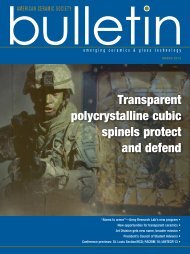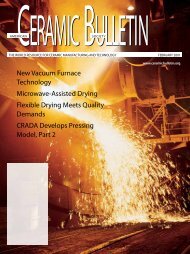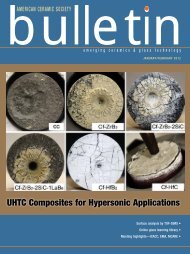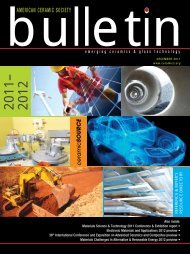American Ceramic Society Bulletin
American Ceramic Society Bulletin
American Ceramic Society Bulletin
You also want an ePaper? Increase the reach of your titles
YUMPU automatically turns print PDFs into web optimized ePapers that Google loves.
ceramics in energy<br />
Disordered TiO 2 nanocrystal surface yields durable, more efficient photocatalyst<br />
By tinkering with the outer layer of<br />
titanium oxide nanocrystals, researchers<br />
at Lawrence Berkeley National<br />
Lab have figured out a way to turn the<br />
material into a tough and more effective<br />
photocatalyst for environmental<br />
and energy applications. They claim<br />
this is the first time durability and efficiency<br />
have been combined in a photocatalyst.<br />
Samuel Mao, an investigator with<br />
the Advanced Energy Technologies<br />
Department of the Lab’s Environmental<br />
Energy Technologies Division, says<br />
they were trying to improve hydrogen<br />
production from organic materials in<br />
water when they had the idea to introduce<br />
disorder in nanophase TiO 2 and<br />
hopefully expand its light-absorption<br />
ability.<br />
The group’s work, “Increasing solar<br />
absorption for photocatalysis with<br />
black, hydrogenated titanium dioxide<br />
nanocrystals,” is published in Science<br />
Express (doi:10.1126/science.1200448),<br />
and may offer a path for generating<br />
hydrogen from organic compounds<br />
found in natural and polluted water<br />
sources.<br />
Mao leads a research team that is<br />
searching for sustainable ways to generate<br />
hydrogen for use in clean-energy<br />
TEM image of a Ti0 2 nanocrystal after<br />
hydrogenation reveals engineered disorder<br />
on the crystal’s surface, a change<br />
that enables the photocatalyst to absorb<br />
infrared light.<br />
(Credit S. Mao, et al; Science Express.)<br />
Mao shows how the disorder-engineered titanium dioxide nanocrystals turned the<br />
material from white to black.<br />
technologies. In a first-of-its-kind<br />
development, the team jumbled the<br />
surface layer of TiO 2 nanocrystals,<br />
a feat that turned the material from<br />
white to black.<br />
Mao’s group used hydrogenation<br />
to engineer disorder in the TiO 2 . The<br />
researchers had a hint the nanocrystals<br />
might be effective over a wider<br />
spectrum of light when they saw that<br />
the material had turned from white to<br />
black after hydrogenation.<br />
After 22 days of lab test using a<br />
full-spectrum solar light simulator<br />
with methanol serving as a sacrificial<br />
reagent, they report that, “We found<br />
that one hour of solar irradiation generated<br />
0.2 Formula 0.02 mmol of H 2<br />
using 0.02 g of disorder-engineered<br />
black TiO 2 nanocrystals (10 mmol·hour<br />
–1 ·g –1 of photocatalysts). This H2 production<br />
rate is about two orders of<br />
magnitude greater than the yields of<br />
most semiconductor photocatalysts.<br />
The energy conversion efficiency for<br />
solar hydrogen production, defined as<br />
the ratio between the energy of solarproduced<br />
hydrogen and the energy of<br />
the incident sunlight, reached 24% for<br />
disorder-engineered black TiO 2 nanocrystals,”<br />
which they attribute to the<br />
nanocrystals new ability to absorb light<br />
from the infrared part of the spectrum.<br />
The group also demonstrated similar<br />
effects when they substituted phenol<br />
and methylene blue for the methanol.<br />
According to an LBL news release,<br />
the group says this is the first time a<br />
TiO 2 -based photocatalyst is able to<br />
convert infrared, visible and ultraviolet<br />
light. “The more energy from the sun<br />
that can be absorbed by a photocatalyst,<br />
the more electrons can be supplied<br />
to a chemical reaction, which makes<br />
black titanium dioxide a very attractive<br />
material,” says Mao in the release.<br />
Theoretical physicist Peter Yu<br />
explains in the release that, “by introducing<br />
a specific kind of disorder, midgap<br />
electronic states are created accompanied<br />
by a reduced band gap.” Yu,<br />
who also is a professor in the University<br />
of California at Berkeley’s Physics<br />
Department, furher states, “This makes<br />
it possible for the infrared part of the<br />
solar spectrum to be absorbed and contribute<br />
to the photocatalysis.”<br />
Mao and his group say they are now<br />
tackling how to reach similar energy<br />
conversion levels in water containing<br />
more commonplace organic compounds.<br />
Visit: http://eetd.lbl.gov/aet n<br />
18 <strong>American</strong> <strong>Ceramic</strong> <strong>Society</strong> <strong>Bulletin</strong>, Vol. 90, No. 4<br />
(Credit S. Mao, et al; Science Express.)






